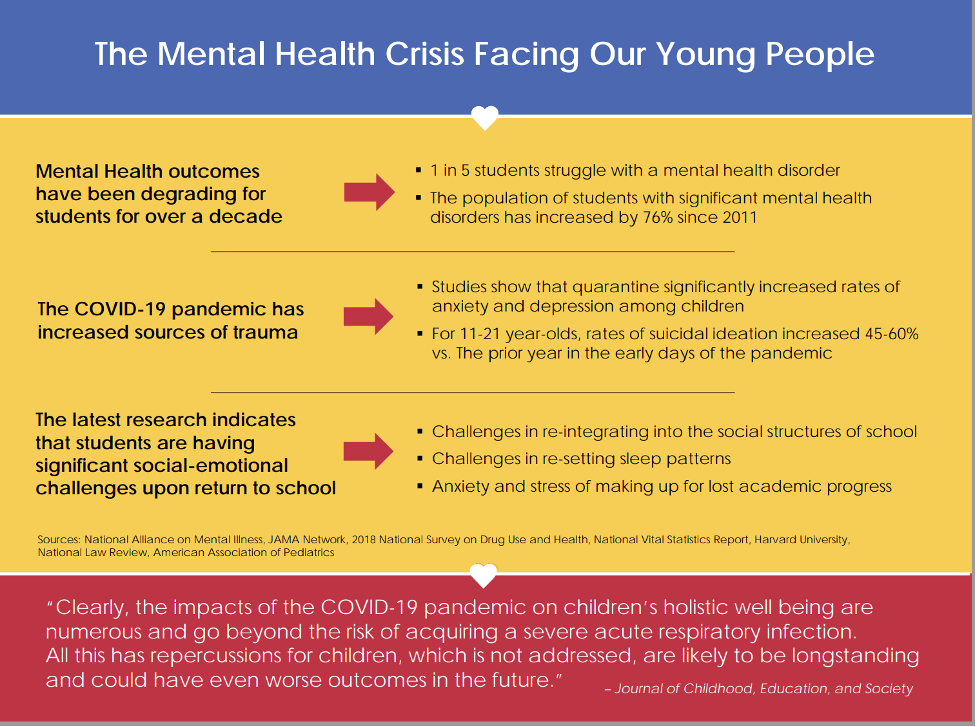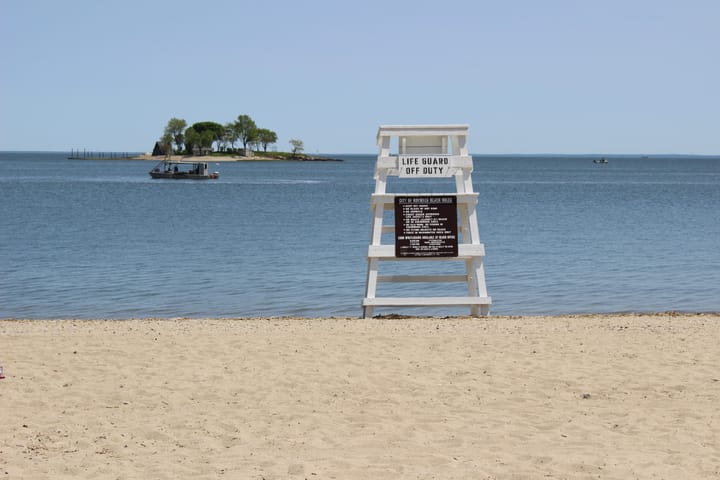How Southwest Connecticut Schools and Communities Continue to Respond to the Mental Health Crisis
Mental health supports and resources have been added across southwest Connecticut.

When Margaret Watt, the prevention director at Positive Directions—The Center for Prevention and Counseling, gave the Norwalk Board of Education an update earlier this month she had some positive news.
“The good news is depression and suicidal ideation decreased significantly,” said Watt, who also runs the Norwalk Partnership, a community coalition focused on supporting young people, which administered the survey. “Things are not OK, but they are getting better.”
Watt briefed the board on results of a survey of the school district on the status of mental health for middle and high school students. She added that while the overall number of students experiencing depression and suicidal ideation were down, “for those of us working in the behavior health field, their level of acuity is higher.”
“It doesn't mean we’re out of the woods,” she said.
The survey results from Norwalk match up with trends both around the state and the country. According to a survey from Pew Research, 76% of parents with children under 18 who participated in the study said they were extremely or somewhat worried about their children struggling with anxiety and depression.
In Connecticut, state legislators passed three bills last session that aimed to expand access to and funding for mental health support. Officials have committed to continue to work on mental health issues this session, with Rep. Liz Linehan, a Democrat from Cheshire and co-chair of the Committee on Children telling CT Mirror that she “cannot imagine a time when children’s mental health will not be a focus.”
This piece is a follow-up to our three-part mental health series published in May, which explored what are the mental health issues impacting southwest Connecticut, how service providers are responding to the crisis, and how you can access resources/get involved with helping address this issue.
Adding Resources in the Schools
For students in need, schools are one of the best resources to provide them with resources and support through social workers, school psychologists, school-based health centers, and more. Across the region, schools have been adding to the available resources to help address the growing need.
Before this school year started, Norwalk Superintendent Alexandra Estrella said that they saw there was a need at the middle schools.
“We saw that our middle schoolers were in a state of crisis,” she told the Board of Education in January. “Our providers brought needed, additional resources to the system.”
Previously, Mid-Fairfield Community Care Center had mental health staff based at the high schools, but expanded to the middle schools to help meet the needs.
“Superintendent Estrella reached out this past summer saying middle schools are in crisis,” she said, adding that they added five new clinicians that are embedded in the middle schools.
In Darien, the community was hit hard last spring when three high school students died—two by suicide. In response, the district opened a wellness center at the high school, which gave students a place to come relax, destress, and get access to supports, such as social workers if they needed.
High School Principal Ellen Dunn said that the first week it was open, more than 300 students visited the center. On average, about 50 students a day visit the center during the two hours it’s open.
“We are exposing all students to all of that support team,” she said. “Students have come up to the guidance suite—it’s been a really wonderful team effort.”
The Board of Education approved hiring a district-wide Director of Mental Health to “oversee the coordination and delivery of mental health programming.”
School officials are also asking for two more positions to increase the mental health supports, particularly at the high school.
The district would like to partner with Kids in Crisis, a local nonprofit that “provides emergency shelter, crisis counseling, and community education programs for children of all ages and families facing crisis.” The partnership would be through the nonprofit’s Teen Talk program, which embeds a mental health counselor at the district. The program is already in multiple schools across the region including Greenwich, Stamford, Norwalk, and Westport.
Denise Qualey, MSW, the managing director of crisis and clinical services, for Kids in Crisis said that the counselor becomes a part of the school district’s mental health team and aims to work with the kids who might be “flying under the radar.”
“It’s the kids that may be having some struggles or concerns in schools,” she said. “The goal of the program is to identify kids who need more support.”
She said that by having the Teen Talk counselor in the building, the students are also connected to Kids in Crisis’ other services, which include 24/7 support and emergency shelter if a student is truly in crisis.
“I probably get three calls a week for a teen talk counselor in a school, and that’s in Connecticut and Westchester [County],” she said. “It’s just the incredible need I think too. The reason I think they call one place over another is the 24/7—a lot of schools are adding outreach staff and school-based health centers and substance staff, but I think it’s the comprehension of the 24/7 of Teen Talk.”
School officials are also asking for a wellness center coordinator who could provide supervision so the center could be open for the entire school day and do community outreach to students and families to let them know the services and resources available.
Dunn said that the Teen Talk counselor and wellness center coordinator would help enhance the work being done this year.
“The biggest hurdle we have is to reduce the stigma associated with that—opening the wellness center this year for partial days was to begin that,” she said. “Our mental health response is not simply reactive, but proactive and preventative.”
In Westport, at the start of the 2021-22 school year, the district brought on Effective School Solutions, a mental health provider that partners with school districts to implement “mental health and behavioral support programs that have been proven to improve care, strengthen academics, address trauma, and maintain students in-district.”
The Board of Education will be receiving an update from ESS on Monday, January 30, but in its report in March, the service provider said that it was “making a critical impact on mental health outcomes for the district, while also creating a cost savings for district financial health.”
The provider offers different levels of interventions, ranging from Tier 1, which includes awareness and outreach, up to Tier 3, which includes “intensive, in-school clinical support,” such as programming for students and wraparound services.
Four students were able to come back into the district from out-of-district due to the supports now available through ESS, and the provider said that three others were able to stay in district, saving it $280,000
Community Connections
In Greenwich, there’s a new youth mental health partnership between Greenwich United Way and Greenwich Hospital that will open an adolescent behavioral health outpatient program this summer. The facility will be at 500 W. Putnam Avenue, which houses Yale New Haven Children’s Hospital Pediatric Specialty Center in Greenwich.
“Greenwich Hospital’s program will include intensive adolescent outpatient services, cognitive-behavioral group interventions and psychotropic medication management,” a statement from the hospital reads. “Additionally, an element of this initiative includes research to improve upon the treatment options for young people.”
Greenwich residents Richard and Ellen Richman are providing $1 million in matching dollars to help support the program, according to the hospital.
“The generosity of Richard and Ellen’s gift addresses an acute need within our community and will transform the availability of mental health care and treatments for adolescents,” said Greenwich Hospital President Diane P. Kelly, DNP, MBA, RN in a statement. “Our nation is grappling with a mental health epidemic that is hitting our younger population extremely hard. Our clinicians see this every single day at Greenwich Hospital, and it is often heartbreaking. No community is immune, including ours.”
Greenwich First Selectman Fred Camillo said in a statement that this will help fill the “current void in accessible mental healthcare.”
“Greenwich is not immune to the nationwide mental health crisis children and teens are facing,” Camillo said.
In Stamford, the city has put together a Youth Mental Health Alliance, which includes more than two dozen members, and consists of mental health providers, city leaders, faith-based leaders, and school officials.
“This is an issue that me and my team hear about on a daily basis,” Stamford Mayor Caroline Simmons said at a December alliance event at the Ferguson Library.
Vin Tufo, chief executive officer at Charter Oak Communities, and member of the alliance said that their efforts include promoting prevention efforts and early screenings to catch needs of students, fill in gaps in care, and distributing the newly created resource guides so people can access services.
While the alliance is focused on youth mental health, Simmons said that the connections established with the group are helping the city work “to address this mental health crisis that we’re in,” for all ages, including seniors struggling with isolation and overwhelmed parents.
One of the efforts that’s come out of the alliance is a postvention plan for the whole community that focuses on responding to untimely deaths.
“Typically postvention is implemented when it’s death by suicide,” Jody Bishop-Pullan, Stamford’s director of health, told the Health Commission in December. “The team also decided that they wanted to look not only at death suicide but also untimely death because there are other things that come up that impact our community.”
Since the postvention team and plan was formed in the late summer, it’s been used multiple times for community response to untimely death, such as to provide resources and support following the tragic deaths of two pedestrians killed in December.
Lorraine Olson, chair of the Health Commission, credited Bishop-Pullan and her team for having the “foresight in the need for a postvention team.”
“It encompasses everybody that is needed when an untimely death occurs—clergy, social workers, the police, schools, everybody in the community,” she said. “We’ve used it several times. It’s just been a phenomenal thing and so, so needed in Stamford.”
Budgetary Questions
While officials have touted the progress these supports have brought to the communities and school districts, many are currently being paid for through federal grants that were made available to address the impacts of the COVID-19 pandemic, such as the American Rescue Plan Act. Local officials are currently working through their budgets for the upcoming year and making decisions about what should continue—and be funded through local tax dollars or another funding source, such as state grants—and what needs to be cut.
Norwalk’s Education Administrator James Martinez urged the Board of Education to work with the Common Council and keep the mental health programs.
“I cannot imagine coming in one day to work without the collaboration of our community providers,” he said. “I get calls everyday about students in crisis—this sounds dark.”
He said the calls happen frequently because there are young people who are “struggling with trying to make sense out of life.”
“We need to make sure these services do not become obsolete especially as we talk about the budget process,” Estrella said.
Watt said that taking away some of the supports and resources could jeopardize a lot of the preventative measures that the district has been implementing.
“Here’s something that could be worse—we’re the only town in the area that hasn’t had a teen suicide, and some of our neighboring towns have had several,” Watt said. “We do have the suicidal ideation. We have kids making attempts. Maybe it’s because of all the resources we have, maybe we’re just lucky. Let’s not pull resources and then go to that dark place.”



